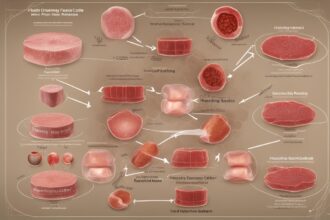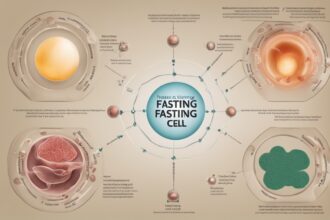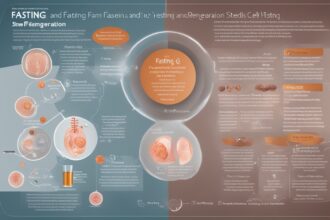Hey there, health enthusiasts! If you’ve been exploring ways to optimize your wellness, you’ve likely stumbled upon the incredible fasting benefits that are making waves in the health community. From weight loss to mental clarity, fasting has been hailed as a game-changer. But did you know that fasting might also play a role in something as cutting-edge as stem cell regeneration? That’s right—fasting could be a key to unlocking your body’s natural repair mechanisms. In this deep dive, we’ll explore the fascinating connection between fasting and stem cells, backed by science, and share practical tips to help you harness these benefits safely and effectively. Let’s get started on this journey to better health!
What Are Stem Cells, and Why Do They Matter?
Before we dive into the link between fasting and stem cells, let’s break down what stem cells actually are. Stem cells are unique cells in our body with the remarkable ability to develop into various cell types, from muscle to nerve cells. They’re essentially the building blocks of life, playing a critical role in growth, repair, and regeneration. As we age, our stem cell activity naturally declines, which can slow down healing and increase susceptibility to disease. Boosting stem cell function is a hot topic in regenerative medicine, and here’s where fasting benefits come into play—research suggests that fasting might enhance stem cell activity (Longo & Mattson, 2014).
How Fasting Triggers Stem Cell Regeneration
Now, let’s get to the heart of the matter: how does fasting influence stem cells? When you fast, your body shifts into a state of metabolic stress, prompting it to conserve energy and prioritize repair over growth. Studies have shown that during prolonged fasting, the body activates pathways that protect and rejuvenate stem cells. For instance, research on mice revealed that fasting cycles can stimulate the regeneration of hematopoietic stem cells, which are responsible for blood and immune system formation (Cheng et al., 2014). This process is thought to occur because fasting reduces levels of certain growth factors like IGF-1, signaling the body to focus on maintenance and renewal rather than proliferation.
What’s even more exciting is that fasting may help “reset” damaged or aging stem cell populations. In simpler terms, it’s like giving your body a chance to clear out the old and make room for the new. This could be one of the most profound fasting benefits for long-term health, potentially slowing down aging and improving recovery from injury or illness.
The Science Behind Fasting Benefits for Stem Cells
Let’s geek out on the science for a moment. Fasting triggers a state called ketosis, where your body burns fat for fuel instead of glucose. This metabolic switch doesn’t just help with weight loss—it also activates cellular processes like autophagy, where cells clean out damaged components. Autophagy is closely linked to stem cell health because it helps maintain a clean, efficient environment for these cells to function (Mihaylova et al., 2014). Additionally, fasting reduces inflammation, which is a major obstacle to stem cell activity. Chronic inflammation can impair stem cell differentiation, but fasting’s anti-inflammatory effects create a more favorable setting for regeneration (Fontana et al., 2010).
Human studies are still emerging, but early results are promising. A clinical trial found that intermittent fasting protocols improved markers of cellular health in participants, suggesting a potential boost in stem cell activity (de Cabo & Mattson, 2020). While more research is needed, these findings highlight why fasting is being studied as a natural way to enhance the body’s repair systems.
Types of Fasting That May Boost Stem Cell Activity
Not all fasting methods are created equal when it comes to unlocking fasting benefits for stem cells. Different approaches can yield varying results, so here’s a quick rundown of the most popular types and how they might impact regeneration:
- Intermittent Fasting (IF): This involves cycling between eating and fasting periods, like the 16:8 method (16 hours fasting, 8 hours eating). IF is great for beginners and may support mild stem cell activation through regular metabolic shifts.
- Prolonged Fasting: Lasting 48–72 hours or more, this type of fasting has shown stronger effects on stem cell regeneration in animal studies (Cheng et al., 2014). It’s more intense and should be done under supervision.
- Time-Restricted Eating (TRE): Similar to IF, TRE limits eating to a specific window each day. It’s less intense but still offers benefits like reduced inflammation, which supports stem cell health.
- water fasting: This involves consuming only water for a set period. It’s a powerful way to trigger deep cellular repair but requires careful planning and medical guidance.
Practical Tips to Safely Incorporate Fasting for Stem Cell Health
Ready to tap into these fasting benefits for yourself? While the science is exciting, fasting isn’t a one-size-fits-all solution. It’s important to approach it thoughtfully to avoid risks like nutrient deficiencies or fatigue. Here are some actionable tips to get started safely:
- Start Small: If you’re new to fasting, begin with a gentle approach like 12:12 intermittent fasting before progressing to longer fasts. This helps your body adjust.
- Stay Hydrated: Drink plenty of water during fasting periods to support detoxification and cellular health. Herbal teas can also be a soothing addition.
- Listen to Your Body: If you feel dizzy, overly fatigued, or unwell, break your fast with a light meal. Fasting should feel challenging but not harmful.
- Refeed Wisely: After a fast, avoid heavy or processed foods. Opt for nutrient-dense options like bone broth, vegetables, and lean proteins to support recovery.
- Consult a Professional: If you have underlying health conditions or are considering prolonged fasting, speak with a healthcare provider to ensure it’s safe for you.
Potential Risks and Considerations
While the fasting benefits for stem cell regeneration are exciting, it’s not without potential downsides. Fasting can be stressful on the body if done improperly, especially for certain groups like pregnant women, individuals with eating disorders, or those with chronic illnesses. Prolonged fasting, in particular, can lead to muscle loss or electrolyte imbalances if not monitored (Johnstone, 2015). Additionally, the research on fasting and stem cells is still in its early stages, mostly based on animal models, so we can’t yet claim definitive results for humans.
My advice? Approach fasting with curiosity but also caution. It’s a powerful tool, but it’s not a magic bullet. Pair it with a balanced lifestyle—think nutritious eating, regular exercise, and good sleep—to maximize its effects on stem cell health and overall wellness. And always prioritize your safety over chasing quick results.
In wrapping up, the connection between fasting and stem cells offers a glimpse into the incredible potential of fasting benefits for our health. From triggering cellular repair to possibly slowing aging, fasting could be a natural way to support your body’s regenerative powers. While the science is still unfolding, the early evidence is compelling enough to make fasting worth exploring as part of a holistic wellness plan. Remember to start slow, stay informed, and listen to your body as you experiment with different fasting methods. Here’s to unlocking a healthier, more vibrant you—one fast at a time!
References
- Cheng, C. W., Adams, G. B., Perin, L., Wei, M., Zhou, X., Lam, B. S., … & Longo, V. D. (2014). Prolonged fasting reduces IGF-1/PKA to promote hematopoietic-stem-cell-based regeneration and reverse immunosuppression. Cell Stem Cell, 14(6), 810-823.
- de Cabo, R., & Mattson, M. P. (2020). Effects of intermittent fasting on health, aging, and disease. New England Journal of Medicine, 381(26), 2541-2551.
- Fontana, L., Weiss, E. P., Villareal, D. T., Klein, S., & Holloszy, J. O. (2010). Long-term effects of calorie or protein restriction on serum IGF-1 and IGFBP-3 concentration in humans. Aging Cell, 7(5), 681-687.
- Johnstone, A. (2015). fasting for weight loss: An effective strategy or latest dieting trend? International Journal of Obesity, 39(5), 727-733.
- Longo, V. D., & Mattson, M. P. (2014). Fasting: Molecular mechanisms and clinical applications. Cell Metabolism, 19(2), 181-192.
- Mihaylova, M. M., Shaw, R. J., & Sabatini, D. M. (2014). Autophagy as a stress response pathway in health and disease. Cold Spring Harbor Perspectives in Biology, 6(5), a008169.






